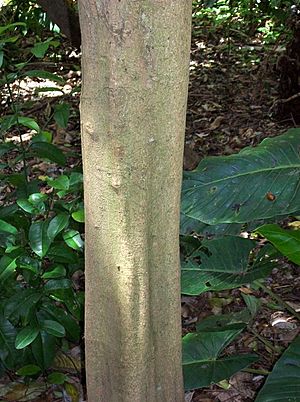Yellow laurel facts for kids
Quick facts for kids Yellow laurel |
|
|---|---|
 |
|
| Cryptocarya bidwillii - flanged trunk | |
| Scientific classification | |
| Genus: |
Cryptocarya
|
| Species: |
bidwillii
|
The Yellow Laurel (Cryptocarya bidwillii) is a beautiful tree that grows in the rainforests of Australia. You can find it from Nymboida in New South Wales all the way up to Townsville in sunny Queensland. It's part of the laurel family, which includes many interesting plants. This tree often grows in drier parts of the rainforest or in thick, viney areas.
Contents
What's in a Name?
The Yellow Laurel has an interesting name! Its scientific name, Cryptocarya bidwillii, comes from a few places.
- The "bidwillii" part honors John Carne Bidwill, who collected the first sample of this tree in Wide Bay, Queensland.
- "Cryptocarya" means "concealed nut." This is because the tree's seed is hidden inside a fleshy part, like a secret package!
The scientist who first described this tree was Carl Meissner, a botanist from Switzerland.
Tree Description
The Yellow Laurel can grow up to 20 meters (about 65 feet) tall, with a trunk that can be 50 centimeters (about 20 inches) wide. However, you often see it as a smaller tree with a wide, spreading top and a short trunk. Sometimes, you might even see new shoots growing from the bottom of the tree.
Trunk and Bark
The trunk of the Yellow Laurel is usually straight and round. On older, larger trees, the trunk might look a bit flattened or have wide bases, like a strong support. The bark is usually smooth and can be grey or brown. You might spot small reddish dots called lenticels or horizontal cracks on the bark. The smaller branches are smooth and have green tips with tiny raised dots.
Leaves
The leaves of the Yellow Laurel grow in an alternating pattern along the stem. They are shaped like an oval, about 6 to 12 centimeters (2 to 5 inches) long, and have a slightly rounded tip. Both sides of the leaf are green and shiny. The edges of the leaves are often a bit wavy. The leaf stalks, which connect the leaf to the branch, are about 5 to 10 millimeters long.
You can easily see the veins on both sides of the leaf, especially on the top. There are usually three to ten side veins that branch off the main vein at a 45-degree angle. The smaller, net-like veins are also easy to spot. On the underside of the leaf, the main vein is raised and a little flat.
Flowers and Fruit
The Yellow Laurel produces small, white or cream-colored flowers. These flowers grow in clusters called panicles. Each flower is about 3 millimeters long, shaped like a bell, and feels a bit hairy. You can usually see the tree flowering between November and January.
The fruit of the Yellow Laurel is a black, round, fleshy fruit called a drupe. It's usually ribbed and has a pointed end, about 12 millimeters (half an inch) across. Inside, the seed is about 8 millimeters wide. The fruit ripens from November to February. Many birds love to eat these fruits, including the rose-crowned fruit-dove, topknot pigeon, and wompoo fruit dove.
Reproduction and Germination
For the seeds to grow well, it's often best to remove the fleshy outer part of the fruit. This helps the seed sprout more easily. The seeds of the Yellow Laurel are known to germinate, or sprout, quite well.

